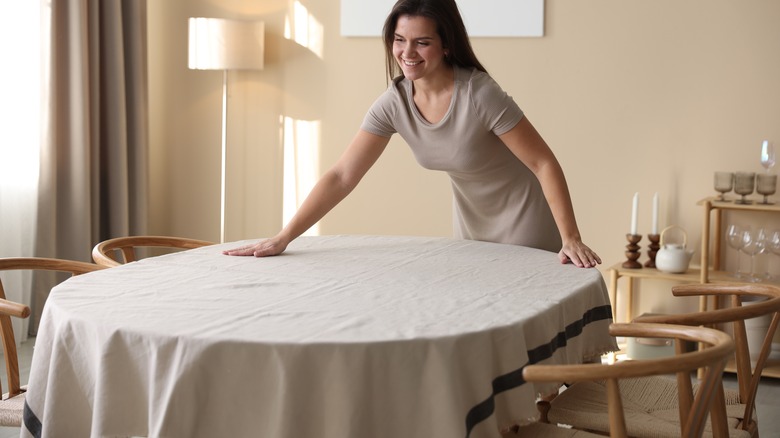The Tablecloth Hack That Will Elevate Your Bedroom In A Way You Didn't Expect
At this point, would you even be surprised if an item in your home that has always served one purpose suddenly went viral on social media for performing three or four other tasks? That seems to be the way the internet is changing common household items, from Lazy Susan alternatives that are far more functional, and now upcycling old tablecloths in your bathroom and as bed linens. There is very little you can't accomplish with a little inspiration from social media platforms, but this trick may be one of the best ways to use thrifted, antique, or just decorative tablecloths that you think are too stylish to let languish under dishware. By layering this piece of fabric along with your existing bedding, you can add dimension and texture, as well as incorporate a unique pattern or print that you may not otherwise find in the store or online as actual bedding.
The main reason this trick is so clever is that it allows you to add to your layered fabrics without needing an entire blanket that could become too heavy or overpower your mattress. Most dining room tablecloths, while large and long, are not the same size as an entire bed sheet or even throw, and many are fairly lightweight. These can range from 60 to 90 inches long, so make sure to keep the size of your bed in mind to avoid too much excess fabric. It's about finding the sweet spot where the cloth will cover your bed without drowning it.
Decorate your bedding with a tablecloth layer
As a genius way to repurpose an old tablecloth in your home, vintage and heirloom tablecloths come in unique fabrics that make for great layering pieces, adding texture to your bed covers. Lace and antique prints are really stylish, but even more modern checkered cloths can work with various palettes. Think of using checkered or striped designs to add a little print to plain bedding sets, or use a simple tablecloth to balance patterned linens. If you've purchased the tablecloth new and it needs to be washed or ironed, do this before adding it to avoid wrinkles. For antique or thrifted pieces, hand wash or spot treat them to avoid damaging the fabric.
Spread out the entire cloth across your bed, so that the longer ends drape over either side. You can also fold it in half to only cover the bottom edge of the bed. The key is to layer your other bedding over it so it blends, either folding the top of your duvet over the tablecloth to slightly cover it, or adding one more layer in the form of a throw or light sheet you've folded to help it blend. Stagger each layer of your bedding so the tablecloth is partially hidden. Just by folding your tablecloth into thirds and placing it at the end of the bed you're bringing in texture, too, if you prefer it to act as more of a throw.
